What I love the most about ground cover plants is it means less weeding for me! There are beautiful ground cover plants that thrive in the shade. My yard is very shady and I had to learn a whole new way of gardening. Take a look at how pretty these ground covers are! Flowers, variegated leaves and even just different shades of green make my gardens beautiful.
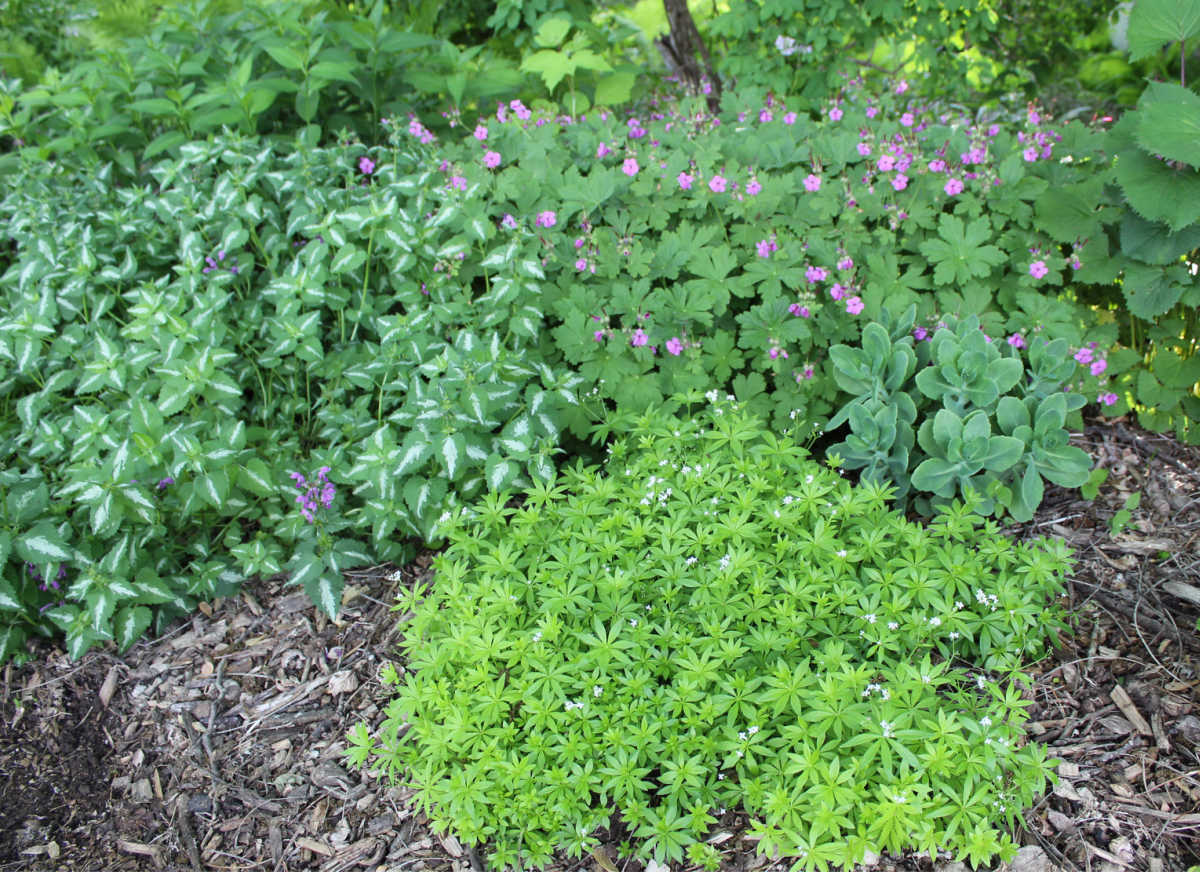
My personal focus for the last few years was to introduce plants as a ground cover in shady areas under the large trees along the whole back perimeter of my yard. If you are learning to garden in shady areas, here is a great resource called 31 perennial shade plants. This post you are now reading is all about ground covers in shady areas.
Table of contents
- Definition
- Benefits of groundcover plants
- Location
- Shady ground covers
- Ferns
- Hostas
- Tickseed Coreopsis
- May Apples
- Wild Geraniums
- Coral Bells
- Variegated Jacob's Ladder
- Sea Heart or Silver Heart
- La mb's Ear
- Anemone
- Snow on the Mountain, aka Bishop's Weed or Bishop's Goutweed
- Sweet Woodruff
- Lily of the Valley
- Lungwort
- Dianthas
- Sources for ideas and inspiration
Definition
I wanted to ensure my interpretation of what a ground cover is was correct. So I looked up the definition of ground covers on Wikipedia
"Groundcover or ground cover is any plant that grows over an area of ground. Groundcover provides protection of the topsoil from erosion and drought."
After quite a few horticultural terms, the plants were also described as being under 4 feet high. I have some wonderfully useful plants to show you! The vast majority are from my backyard. I'm happy to share my personal experience with them!
Benefits of groundcover plants
These lower-growing, spreading plants essentially help cover the ground, whether it's a garden or just space in your yard. The benefits I have found are they are a cost-saving investment once established. I like my yard neat. I don't like weeks. Mulch in larger quantities is expensive and a lot of work. Plus it only lasts for a couple (few) years and then you do it all over again.
By planting these types of plants, you prevent weeds from growing. Weeding can be a never-ending job! This is a way to prevent weeds from even being able to establish themselves. The hours saved from not having to weed is one of the main reasons I'm establishing groundcovers.
Also, per the definition above, these plants also protect against erosion and drought.
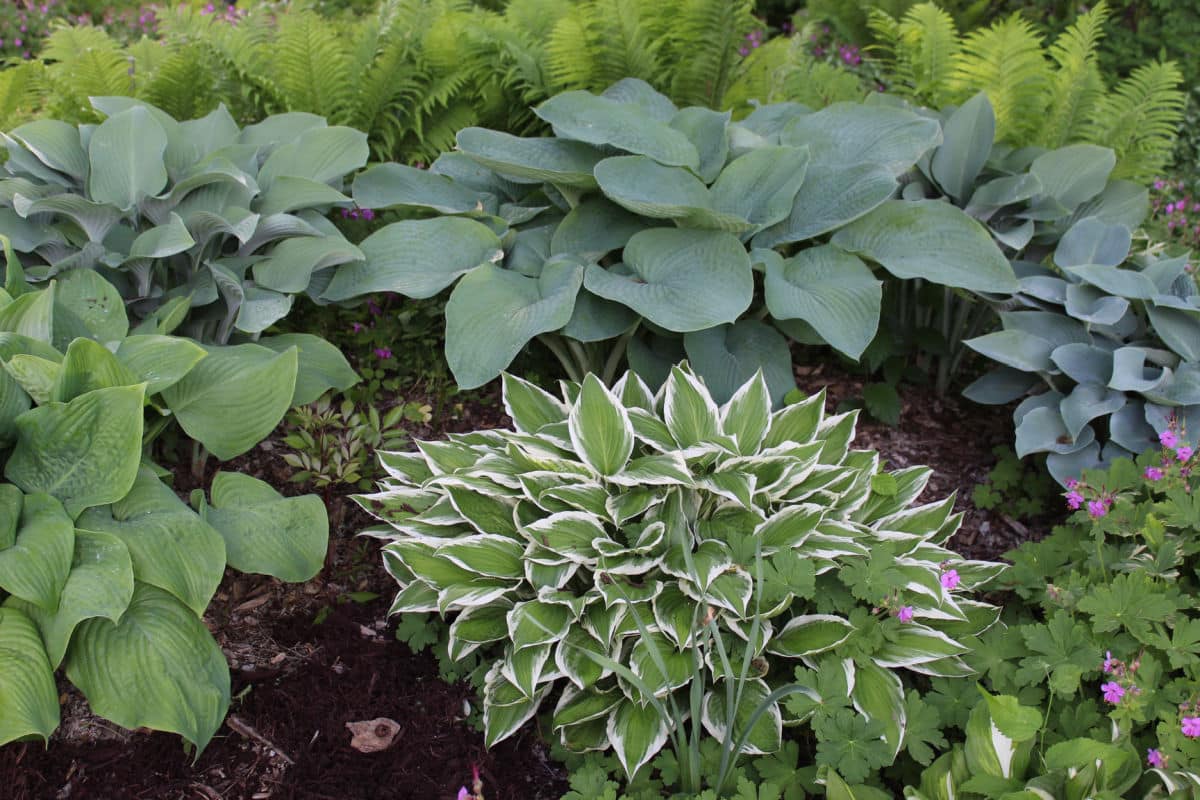
Location
My gardens are located in Wisconsin and I am in USDA zone 5. This is important to know for two reasons.
- Some perennials can't survive from year to year with our winters and are thus treated as annuals. That's something to look at when planning your gardens. Is the plant truly a perennial in your zone and will spread year after year? Or, in your area, is it considered an annual?
- In areas further south that don't get the cold weather, some perennials are much more aggressive because they don't die back in the winter. Planting an aggressive or invading plant in a zone that encourages too much spread will have you weeding that perennial to control its spread. Or, you'll be trying really hard to remove it.
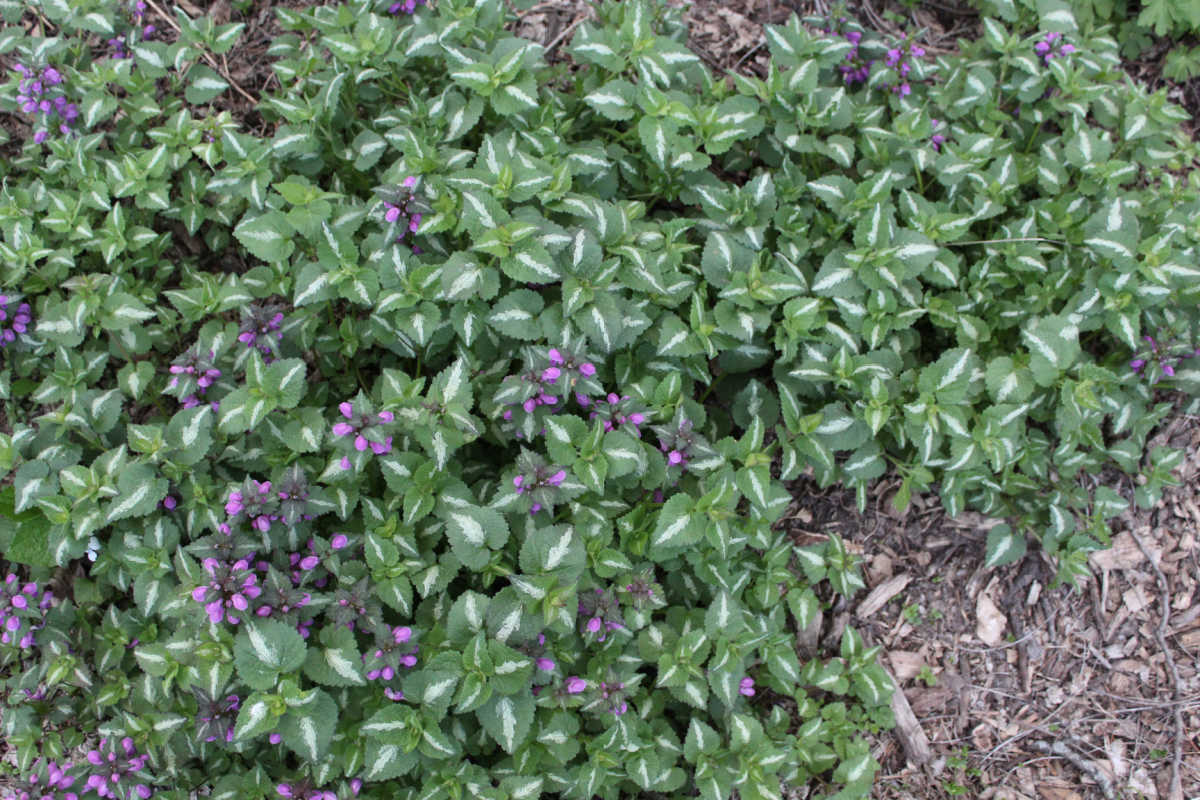
Shady ground covers
The plants I'm sharing with you are all in shadier areas of my yard. Some plants can be planted in a little more shade or a little more sunlight than the tags state. However, it's sometimes an experiment. If the plant isn't thriving, it may need to be moved.
Ferns
Ferns are a traditional shade plant. Most of the ferns in my yard are ostrich ferns (Matteuccia struthiopteris). They are lovely in more moist soils and grow well in USDA hardiness zones of 3-7. Some people don't like how ostrich ferns spread, but I love it. I find these are such a pretty backdrop to my shade plants. Many fern types exist, so choose the ones that do the best in your area. Neighbors, local online resources, or local nurseries can guide you about this.

I love little baby ferns and watch for them in the spring. At this stage, they are called fiddleheads. Some ferns are edible, and fiddleheads can be pretty delicious! They taste similar to spinach to me.
Creeping Jenny
The yellowish low-growing plants in the picture below are creeping Jenny. It is also known as moneywort. This plant has small yellow flowers, and I always seem to miss them!
This plant is also nice in container gardens since it trails nicely and does a good job as the "spill" feature. If you have this growing in your yard, just transplant a few into your planter and save some money!
This plant is zoned 4 - 9. This plant can grow very aggressively but in my zone 5 yard, I have not had an issue.

Finding shade plants that are pretty sometimes requires you to be a visual learner. An uninspiring plant at the store can surprise you and be beautiful in your garden as an early spring bloomer. This Brunnerea macrophylla for example, has the prettiest little flowers early in the spring.
Hostas
Simple variegated hostas
These are some of the most common types. I hadn't even moved into my current home and a neighbor came over with a box of these! I knew I moved to the right place. Hostas can be split and shared easily.
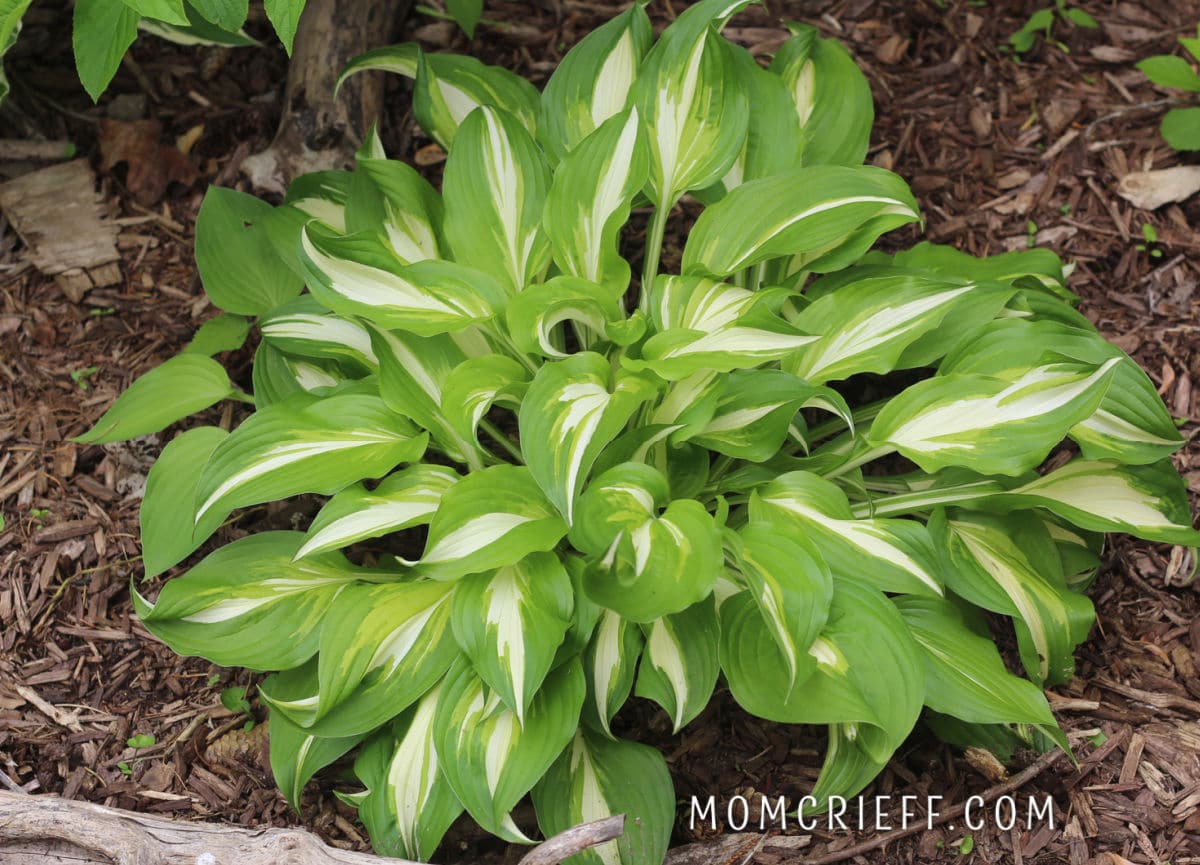
Variegated hostas often have white on the inside OR the outside. These are the ones people talk about not being able to kill. They survive under woodpiles for years. Or grow in compost piles. They add a pretty color contrast to parts of the yard that don't get much sun.
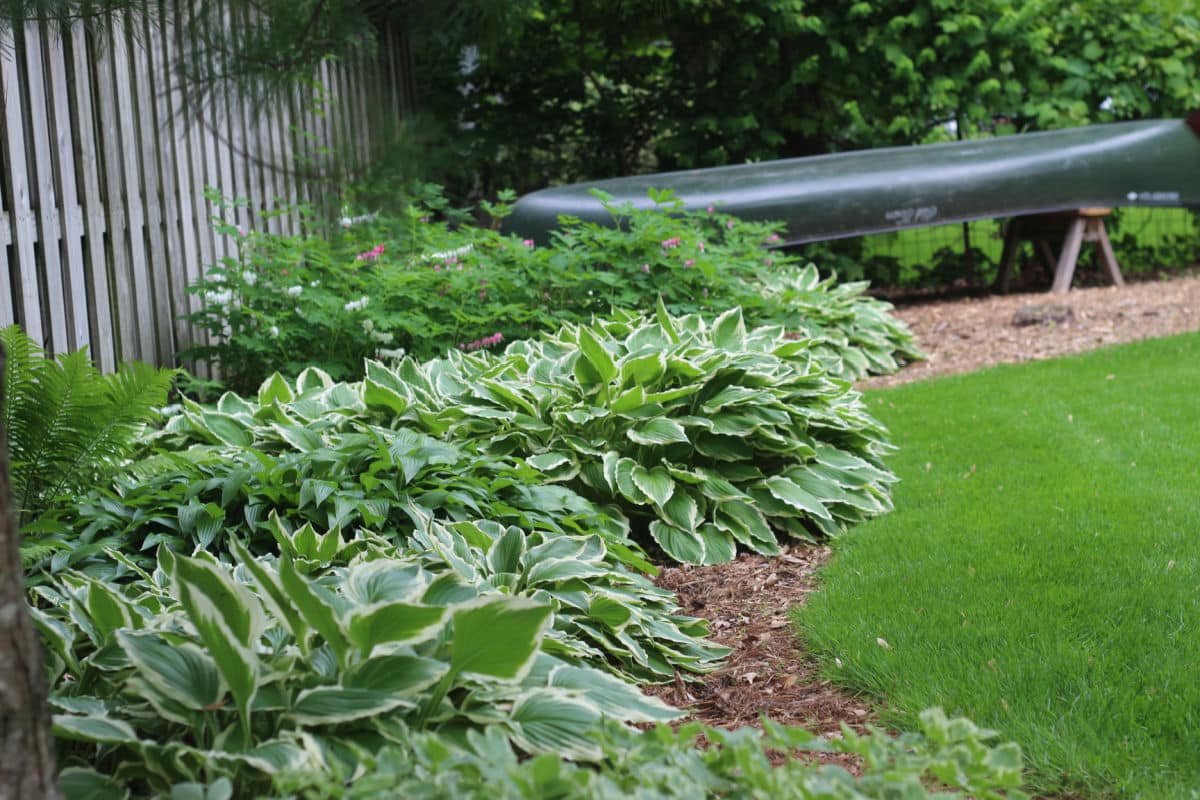
Fancier hostas
I have some large-leaf blue-colored hostas, and I love them! One of the most common is called the Blue Angel Hosta. It grows in zones 3-8. I have it growing in dappled sun, which is perfect for this hosta. It grows well in partial sun to full shade. Most hostas are shade-loving perennials that brighten the yard's darker areas. There are hundreds of different kinds of hostas!

I think this image helps you see the pretty blue color of some hostas! This shows some of the variations of different colors and patterns available for hostas.
Tickseed Coreopsis
This plant is officially a sun plant. I've had it in a partial shade location, and this plant's tolerance for shade is better than expected. It only had a couple hours of the morning sun, then shade for the rest of the day. It's rated for zones 3-10. These are excellent perennials for shade that bloom all summer. This one is happy with a fair amount of shade as long as it has good soil.
I love the texture of the foliage! A very easy plant to take care of!
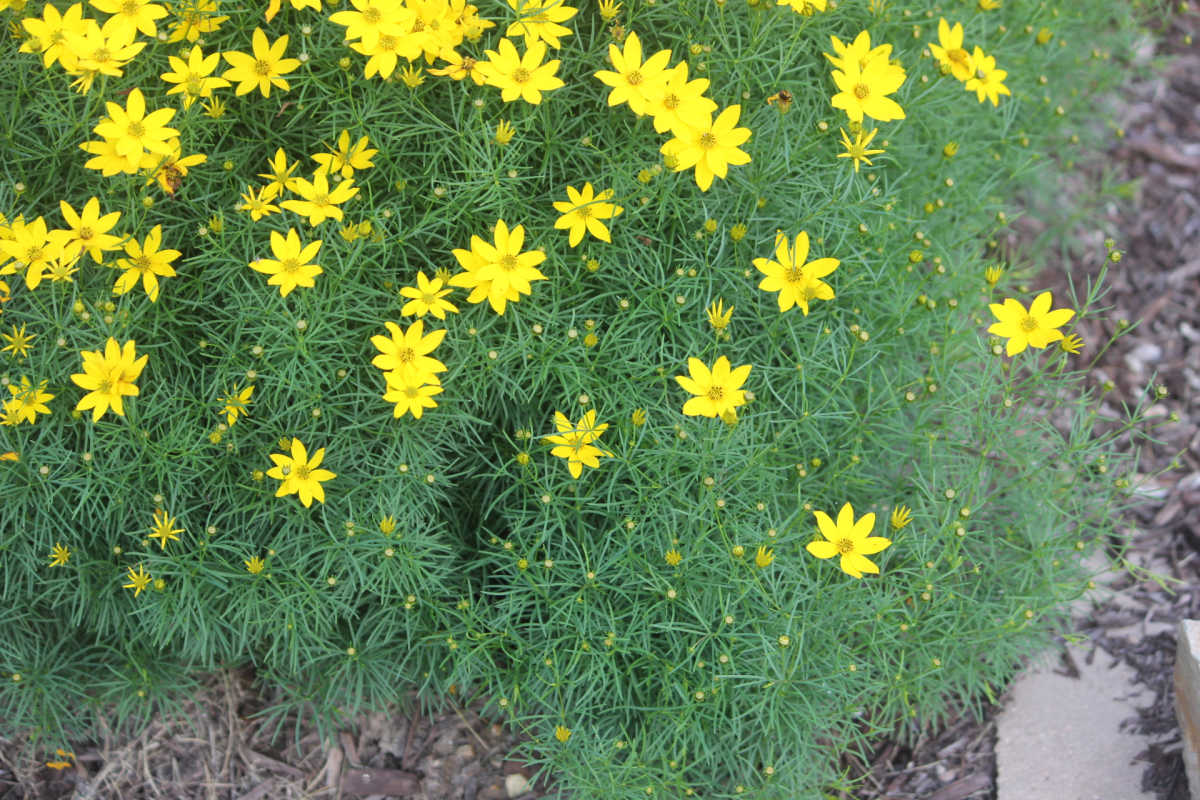
May Apples
I have a corner of my yard with quite a few different trees where a small natural woodland area is developing. I LOVE seeing these local plants growing.
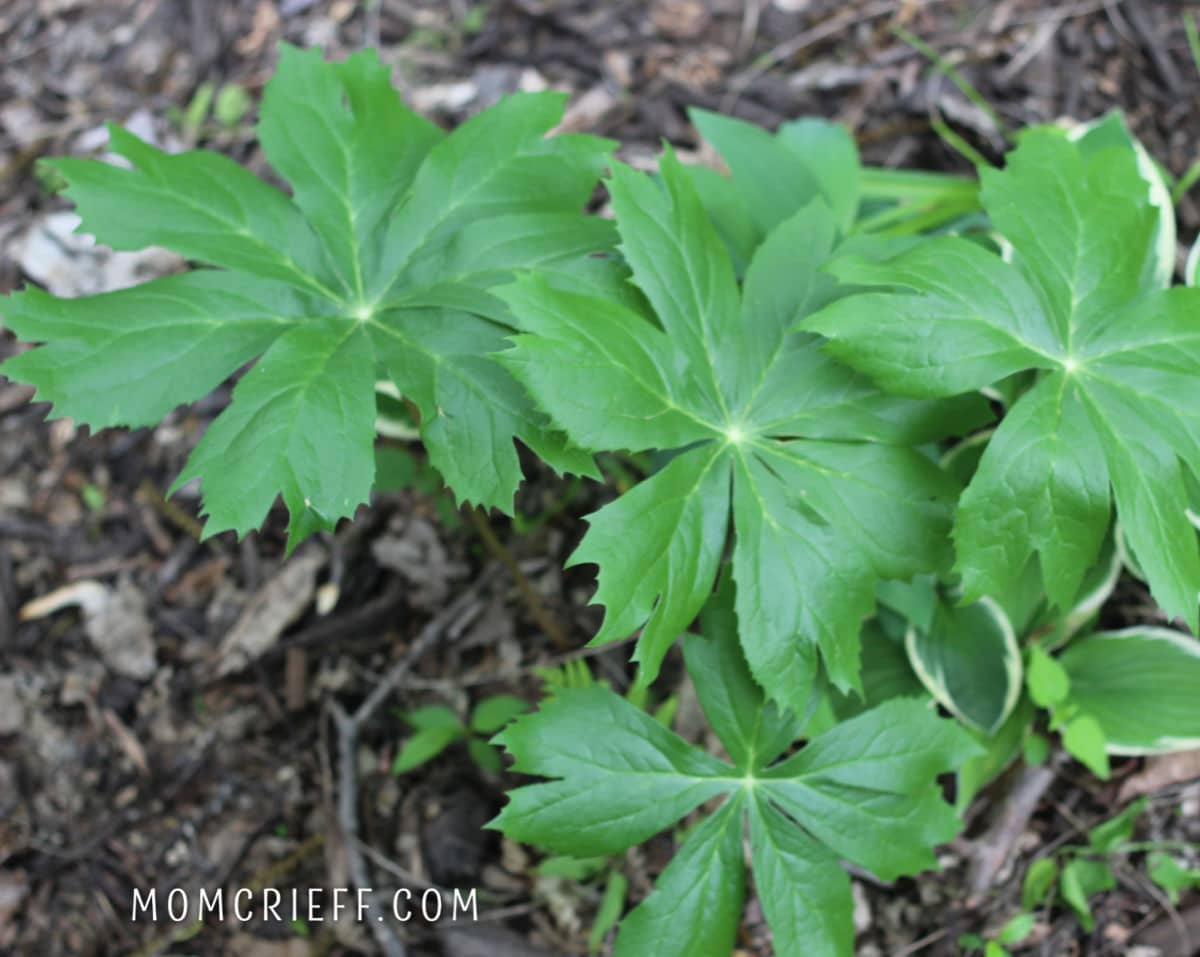
The May Apple (podophyllum peltatum) grows in zones 3-9 in partial sun to shade areas and likes moist but well-drained soil. It does bloom and has a flower resembling a strawberry flower under its leaves. It grows early in the spring and that's why I enjoy seeing it.
Wild Geraniums
One of the easiest to care for plants in my shade gardens is the wild geranium. I've also heard it called cranesbill and hardy geranium. Wild geranium (Geranium maculatum) grows in USDA hardiness zones 3-8. These are native North American plants. That's why they probably grow so quickly and spread well but are easy to pull if they spread too much. These are such easy-to-grow flowering plants for shade. The bees love them! Once finished blooming, I trim them back and am often rewarded with a second flush of blooms.
My one caution about this plant is that I would not plant it in a high-traffic area. The bees love it!
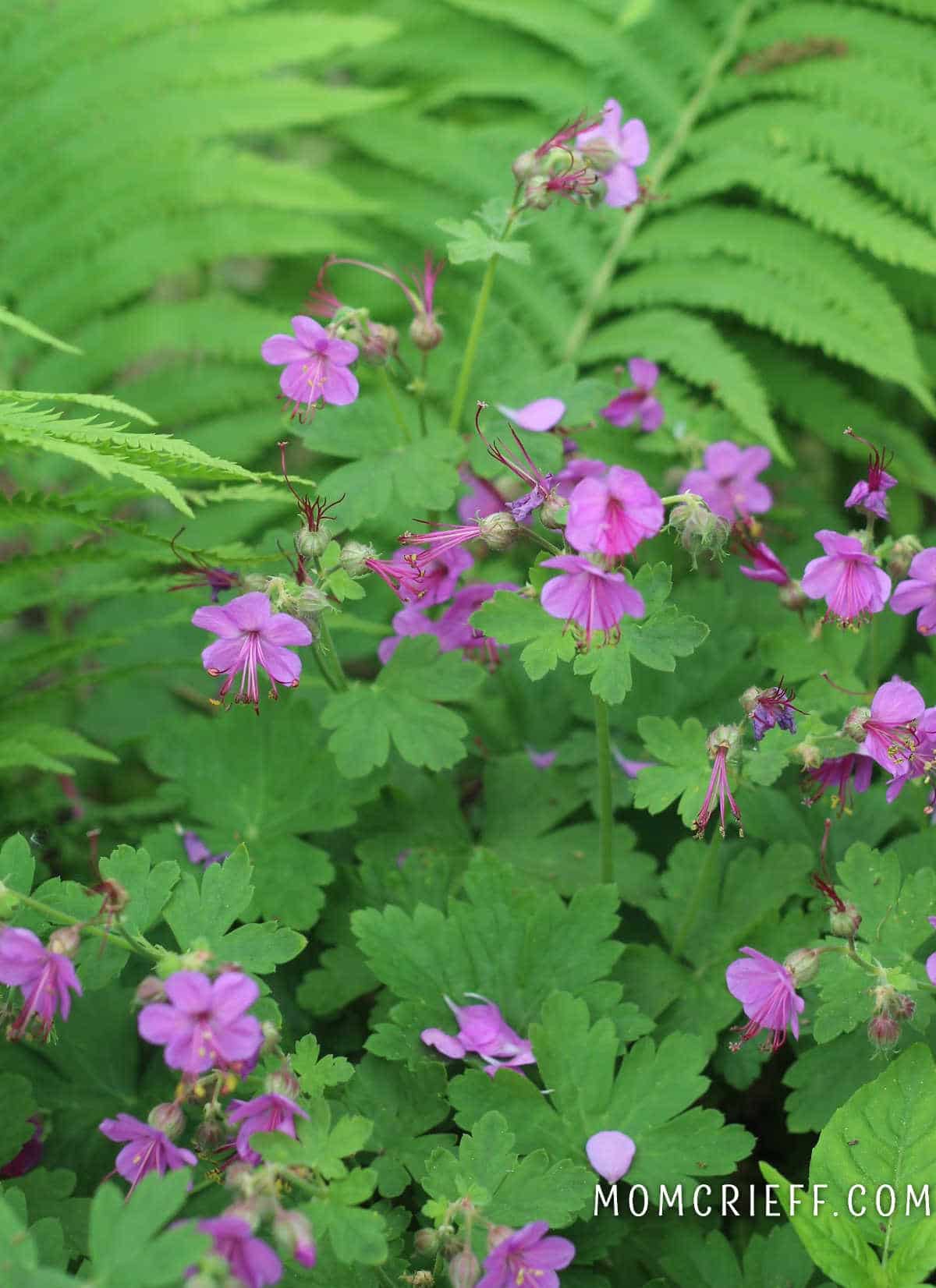
Coral Bells

Coral Bells (Heuchera) come in many different colors. They have spikey flowers; most are grown for their leaves, not their flowers. Coral Bells is a hardiness zone of 4 - 9. If you buy some of these, make sure you buy a color that stands out against your mulch. Or at least contrasts with plants that are planted close.
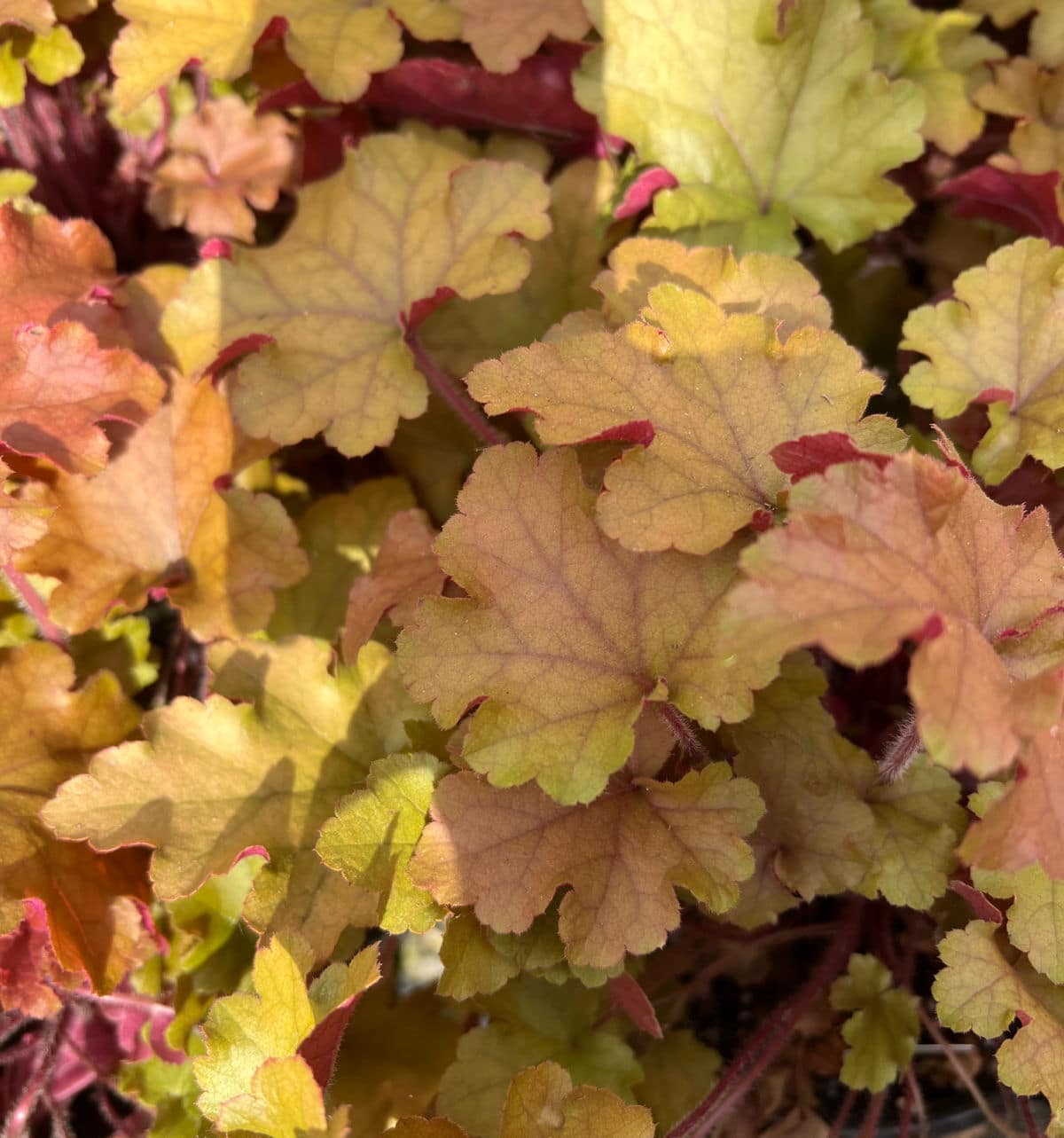
Variegated Jacob's Ladder
I was in love with this version of Jacob's ladder (Polemonium) the first time I saw it in my neighbor's yard. It looks delicate, but it's a zone 4-8 perennial. The tag said it was deer-resistant and attracted butterflies. The staff person at the nursery said the bunnies in her yard didn't eat them. The variegated leaves and the delicate purple flowers made me want to buy this one. It's a perfect shade plant!!
You can usually tell how happy a plant is with its location when it flowers.
This plant is known to be partial to full shade. So, definitely no afternoon sun!
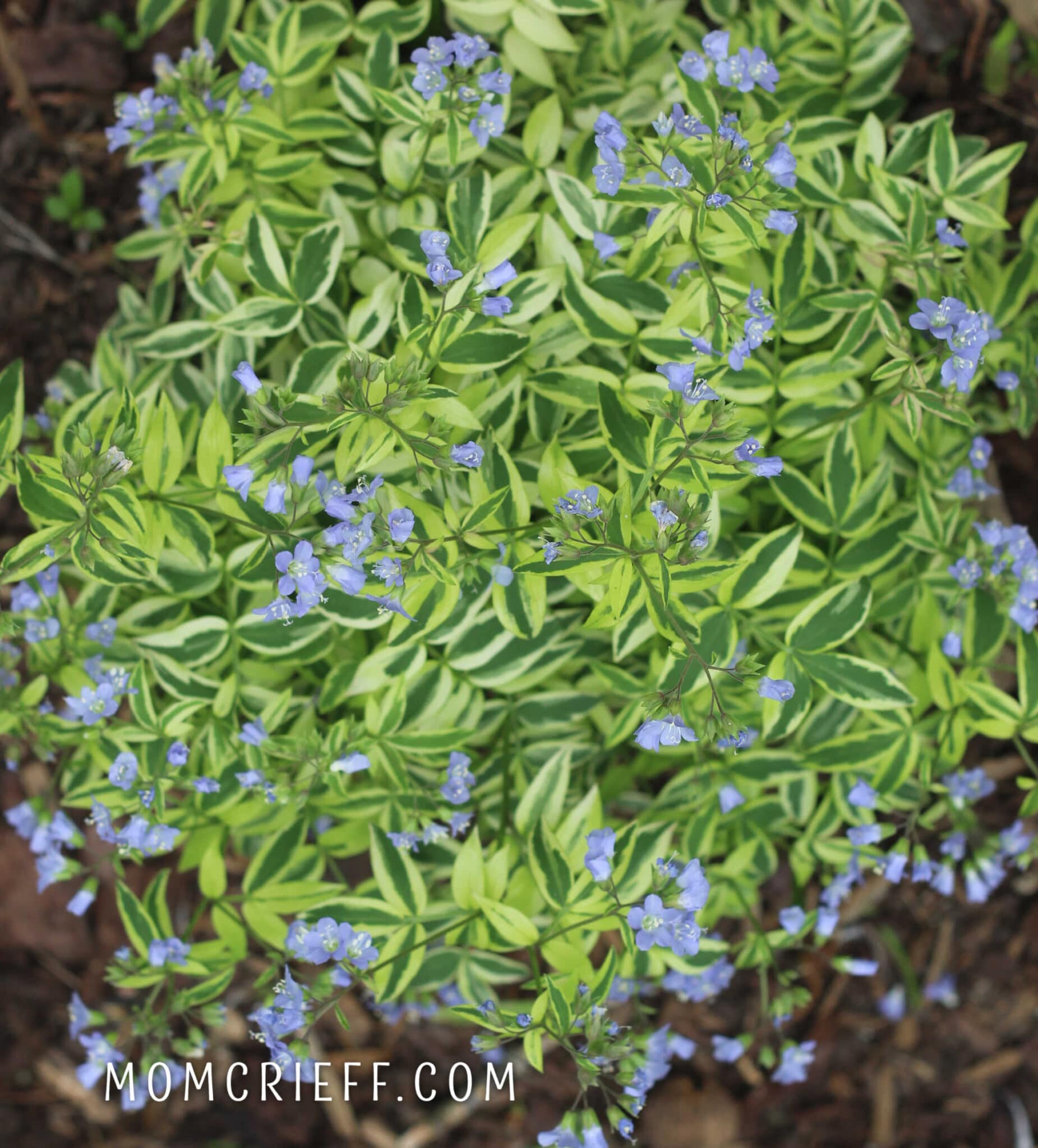
Sea Heart or Silver Heart
These names are also common names for brunnera plants!
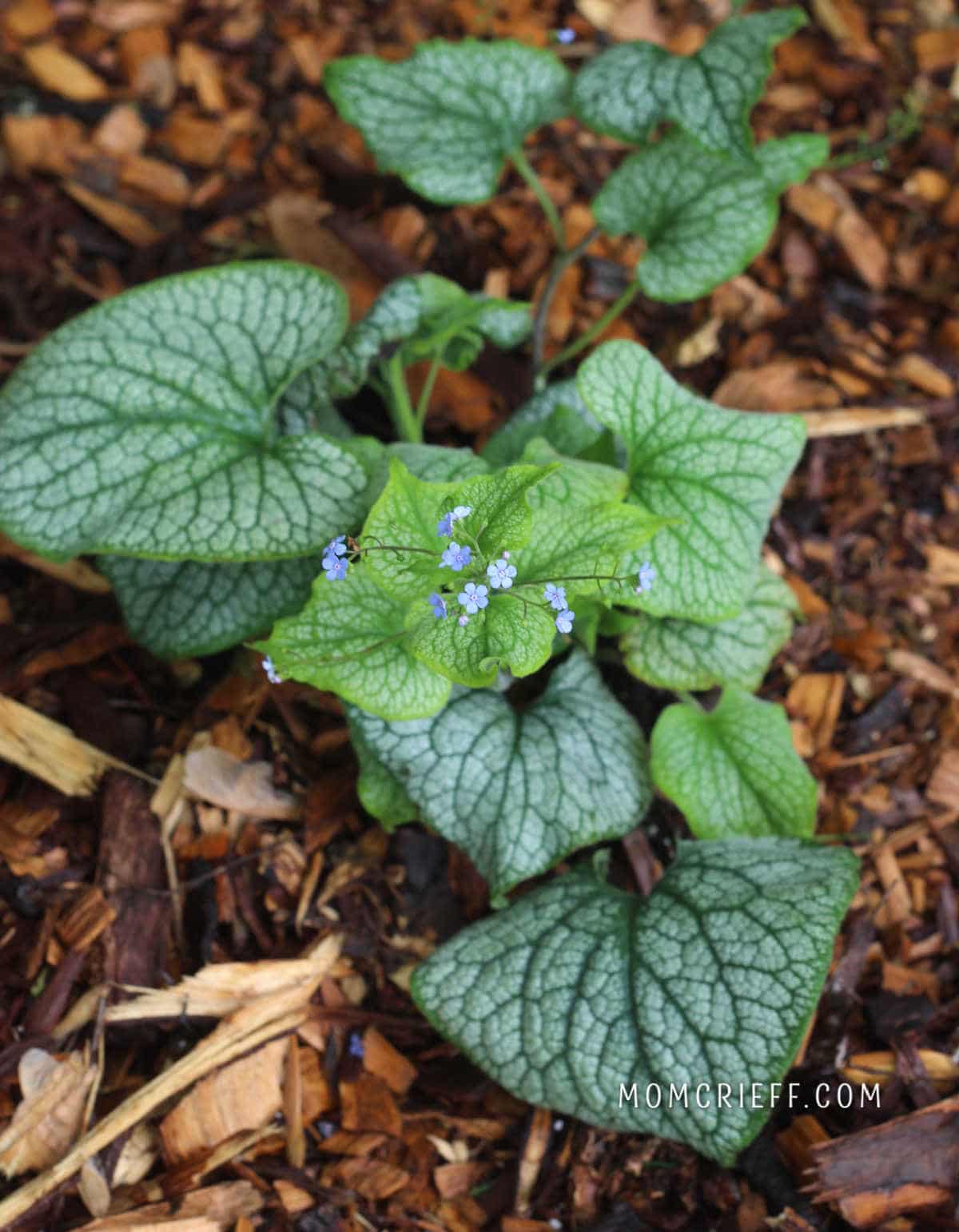
There are different varieties of this plant. Above is Alexanders Great and below is Jack Frost. It's the variegated leaves that make this plant striking in the shade.
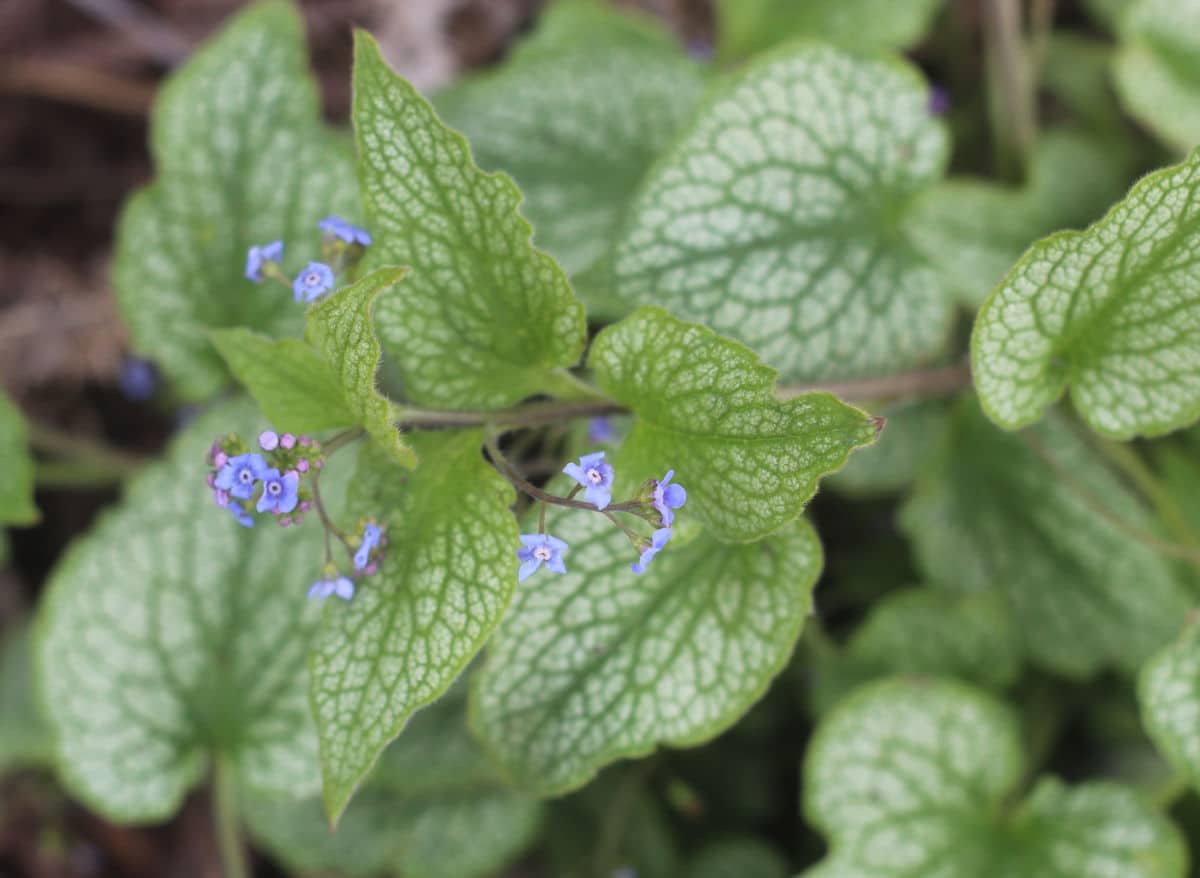
This beautiful plant (Brunnera macrophylla) is a perennial that grows in USDA zones 4-9. It has beautiful big silvery leaves, and it's the leaves that make this plant stand out. It is a shade to part shade plant. I've heard great things about how it grows! If you'd like more info about this plant, take a look at this post dedicated to the brunnera macrophylla shade plant.
Lamb's Ear
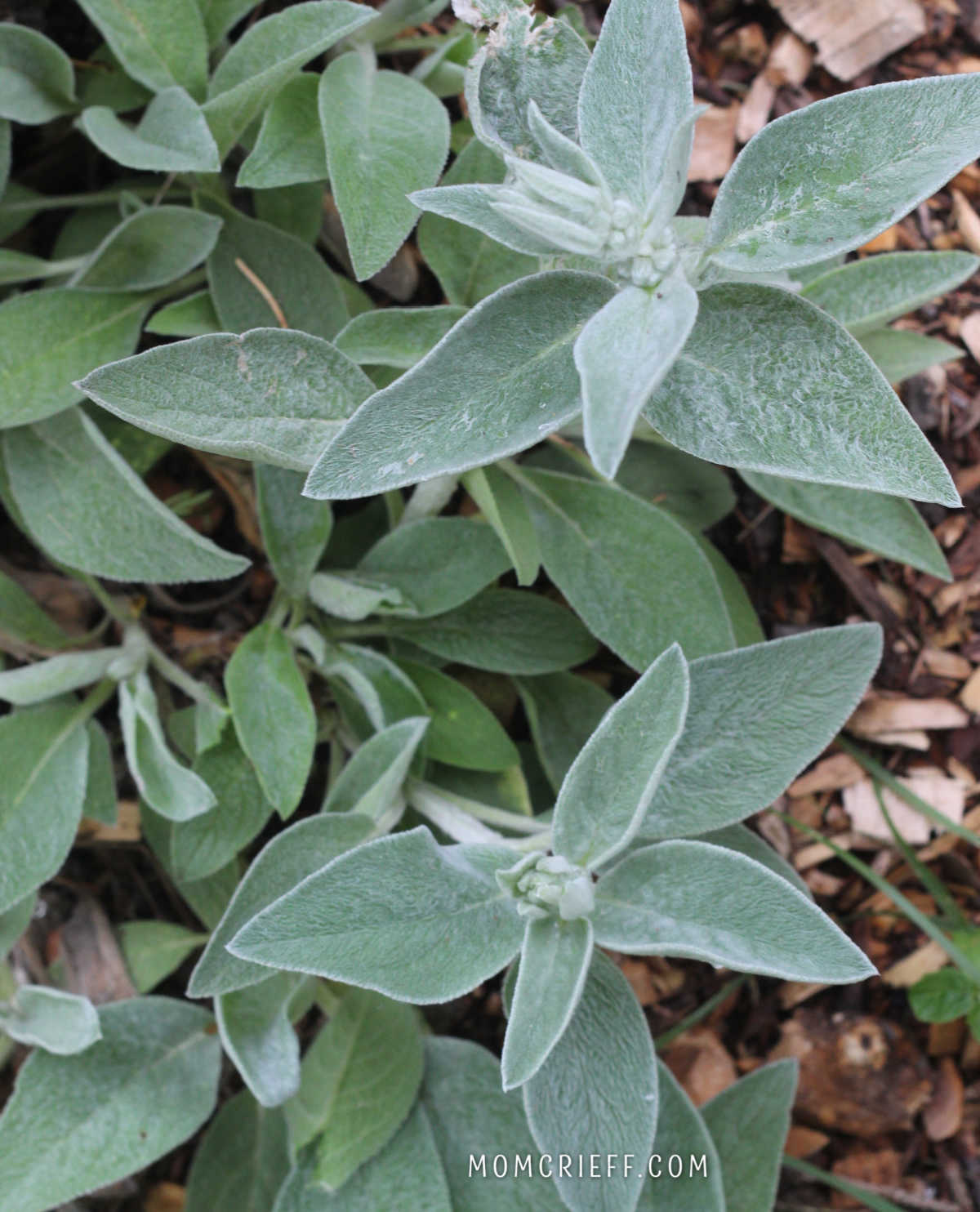
Lamb's ear (stachus byzantine) is a tough little perennial that grows in zones 4-8. This plant is a silvery light green with soft velvety leaves. It's because of the softness of the leaves that this is my favorite. I do love it as a groundcover, but I will warn you that it does spread. I find it easy to contain, and any plants that are where they shouldn't be can be pulled up easily. There are pink/purple flowers on a taller stem, and I've found bees seem to enjoy these flowers.
Anemone
The name of this Anemone was "pretty Lady Susan." I 100% bought it because my name is Susan! Gardening should be fun and personal, right?
Amemones are also known as windflowers. I know I've bought it in the past and think I've mistaken it for a weed. There are quite a few anemone varieties that don't bloom until late summer or early fall. But they do spread as a groundcover during the summer (why I thought it was a weed). They are nice to see when other flowers are fading at the end of the summer.

This is a partial shade plant with a zone hardiness of 5-9. It has pink blooms on a taller stalk in late summer or early fall. This plant has spread quite a bit in its second year in my garden.
Snow on the Mountain, aka Bishop's Weed or Bishop's Goutweed
The Bishop's weed is to the right of the trunk in the image below. If you have it in your gardens, aggressively work to keep it under control. If you don't have it yet, don't plant it. You and your neighbors will regret it!

This is the variegated version. There is also a solid green version.
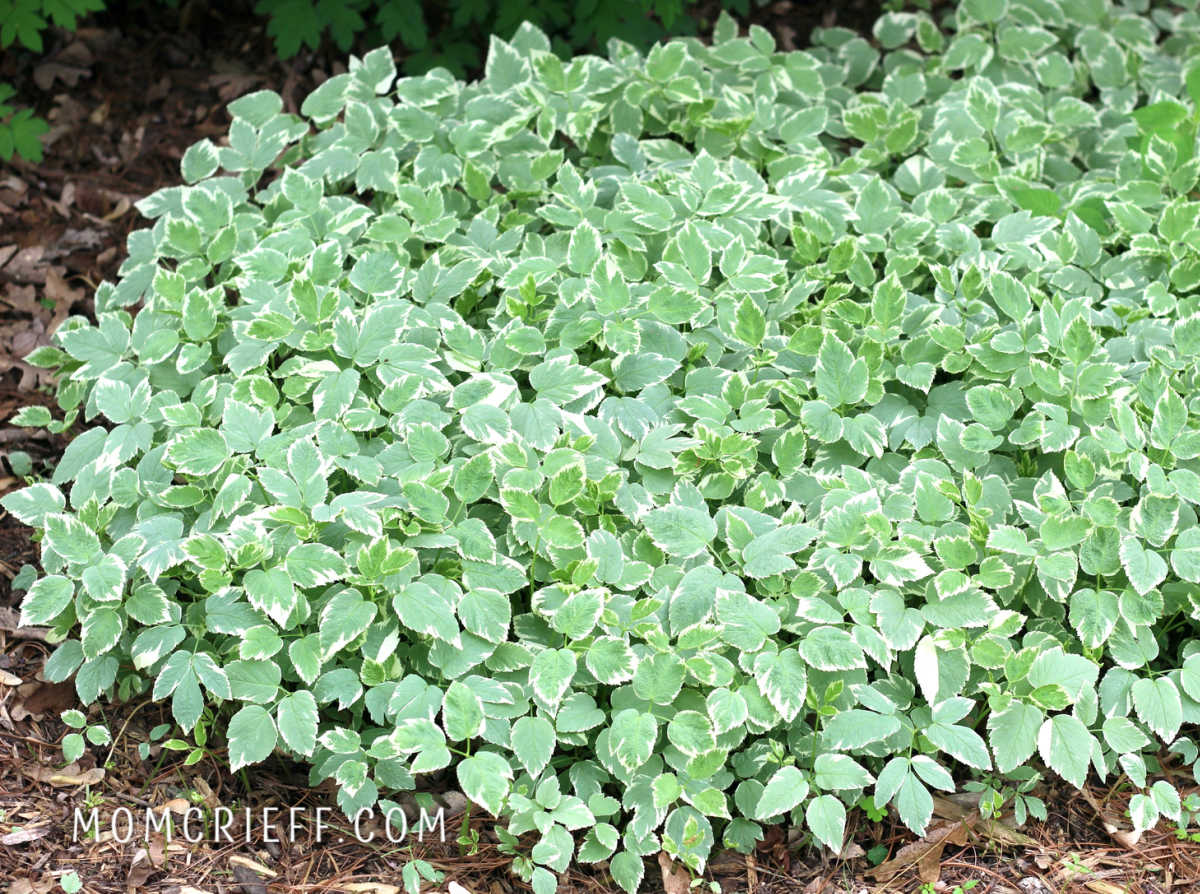
When I first moved into my home, one whole side of my house had this in its garden. Because I knew how invasive this plant was, I used a chemical treatment to help kill it off. Then, I used cardboard covered by mulch to smother future growth. Four years later, it still peeks up in that area. Using cardboard as weed control is a great way to continue a non-chemical weed prevention method.
Sweet Woodruff
This is a nice low-growing plant with the prettiest tiny white flowers.
This is one of my favorite groundcovers because of those flowers! I also like the shape of the leaves. It's rated zones 3 -9 and is drought tolerant. Many people don't realize how dry it can be under a tree's canopy. Unless there is quite a bit of rain, the ground doesn't always get wet because the tree leaves shelter the ground from the rain.
This spreads quickly but is not considered aggressive. I am planning to move some of it to the front of my shade beds because I love its low-growing nature.
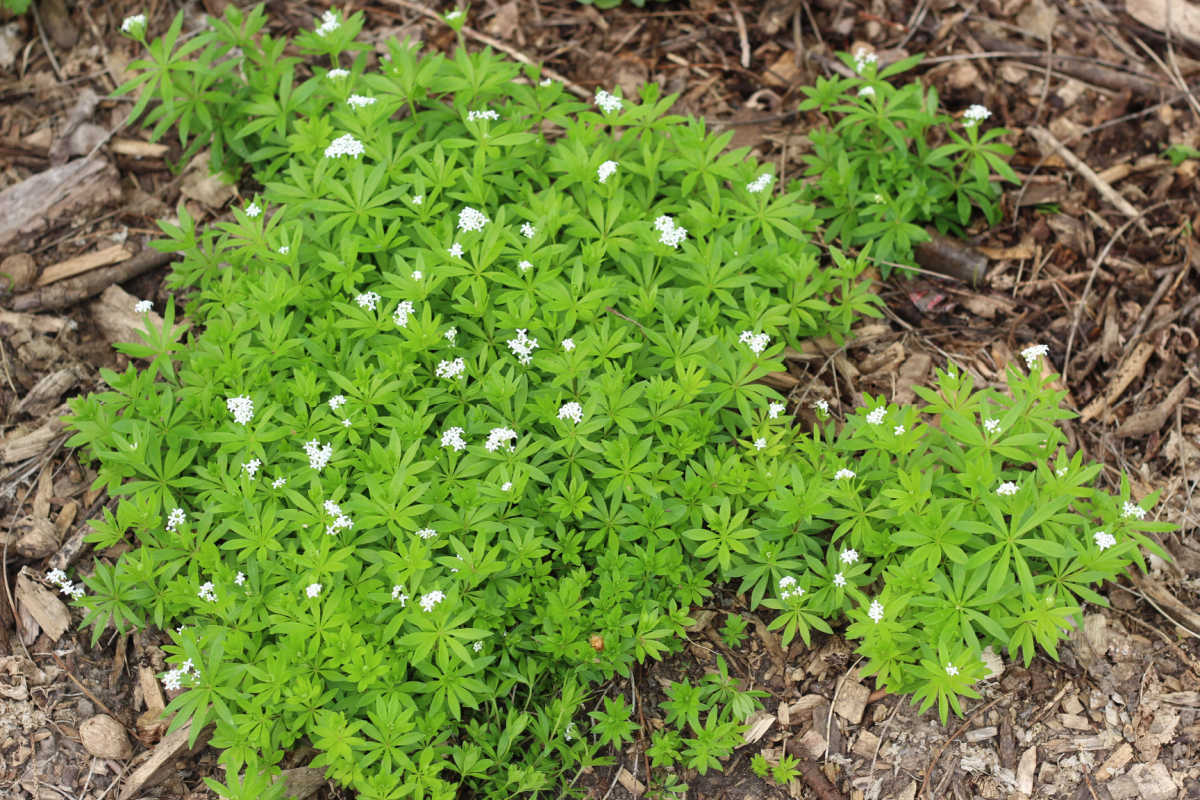
Lamium | Spotted Dead Nettle
Oops. I planted this lamium in the back of my yard, not realizing it is considered invasive. It has really spread over the past year but has been easy to manage by just pulling out the plants that have grown where I don't want them. I will be keeping a very close eye on this one! I'm always amazed that gardening stores sell plants that will become a problem.

The flowers of this plant, along with the variegated leaves, are pretty. It flowers all summer, and I see many bees on it.
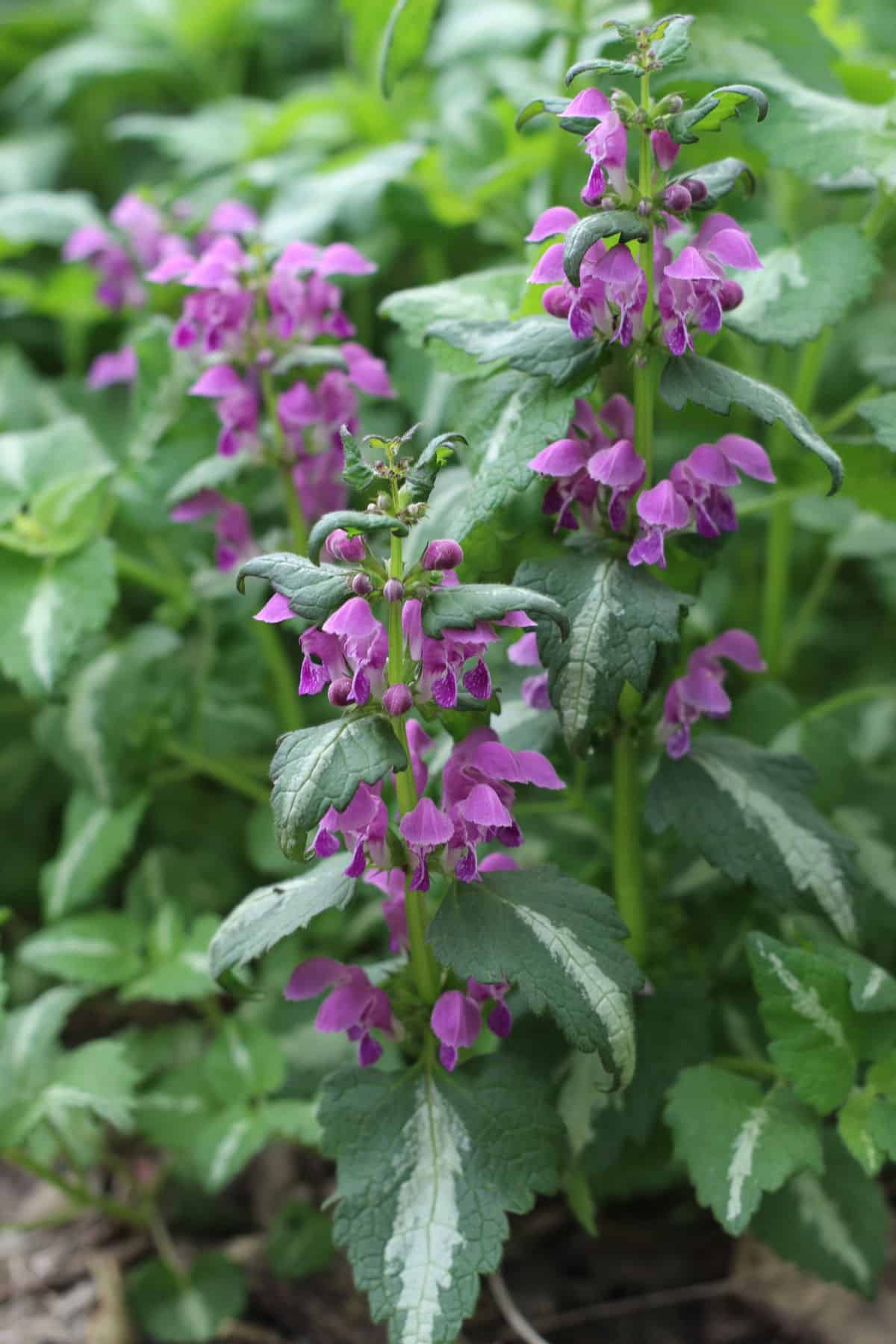
Sedum
There are a huge number of sedums that are low-growing, spread, and are fine in partial shady areas.
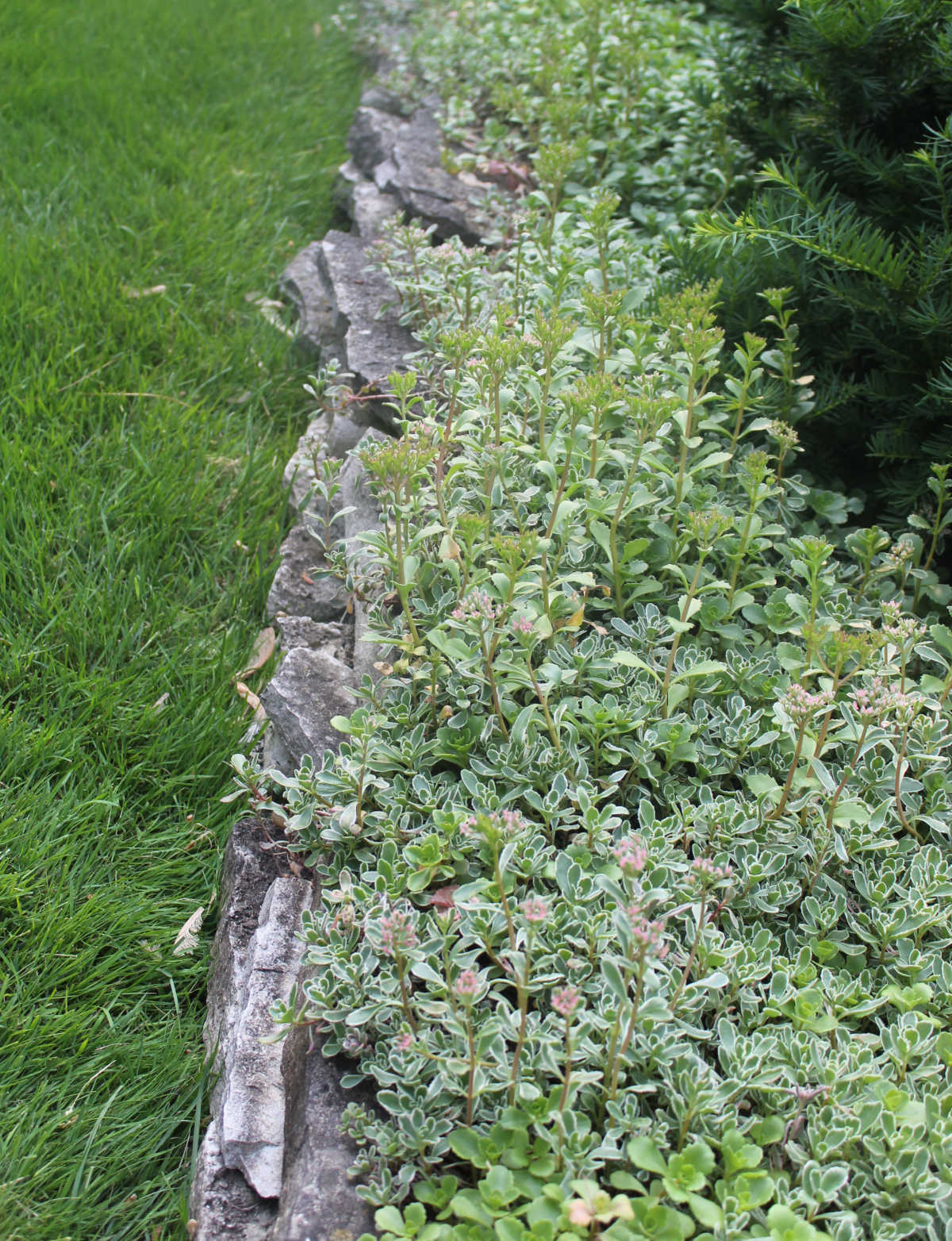
This is a mix of different sedums and looks so cute on a small rock wall.
If purchasing, make sure you are buying the low-growing mounding type of sedum. You don't want to get a taller variety if you haven't planned for it. USDA zones include 3 - 9.
Coleus
In my zone 5 area, this is an annual. But I like to grow it because of the different colors available. For many years I have had a flat with mixed colors. This plant also does well as a houseplant. My plan is to propagate some of the stems in water and grow them as a houseplant this winter.
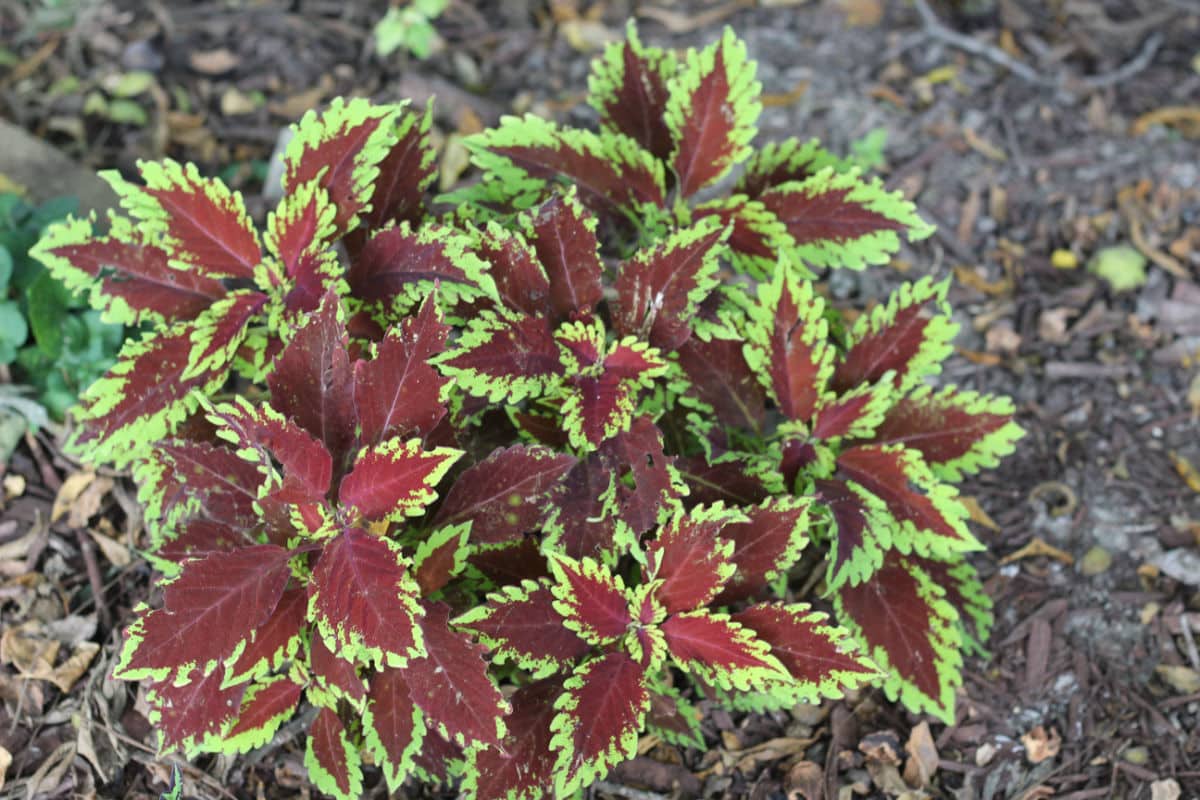
I have a shady, grassy area that I thought was boring. I added this tree stump with this metal planter on top to give the area some visual interest.
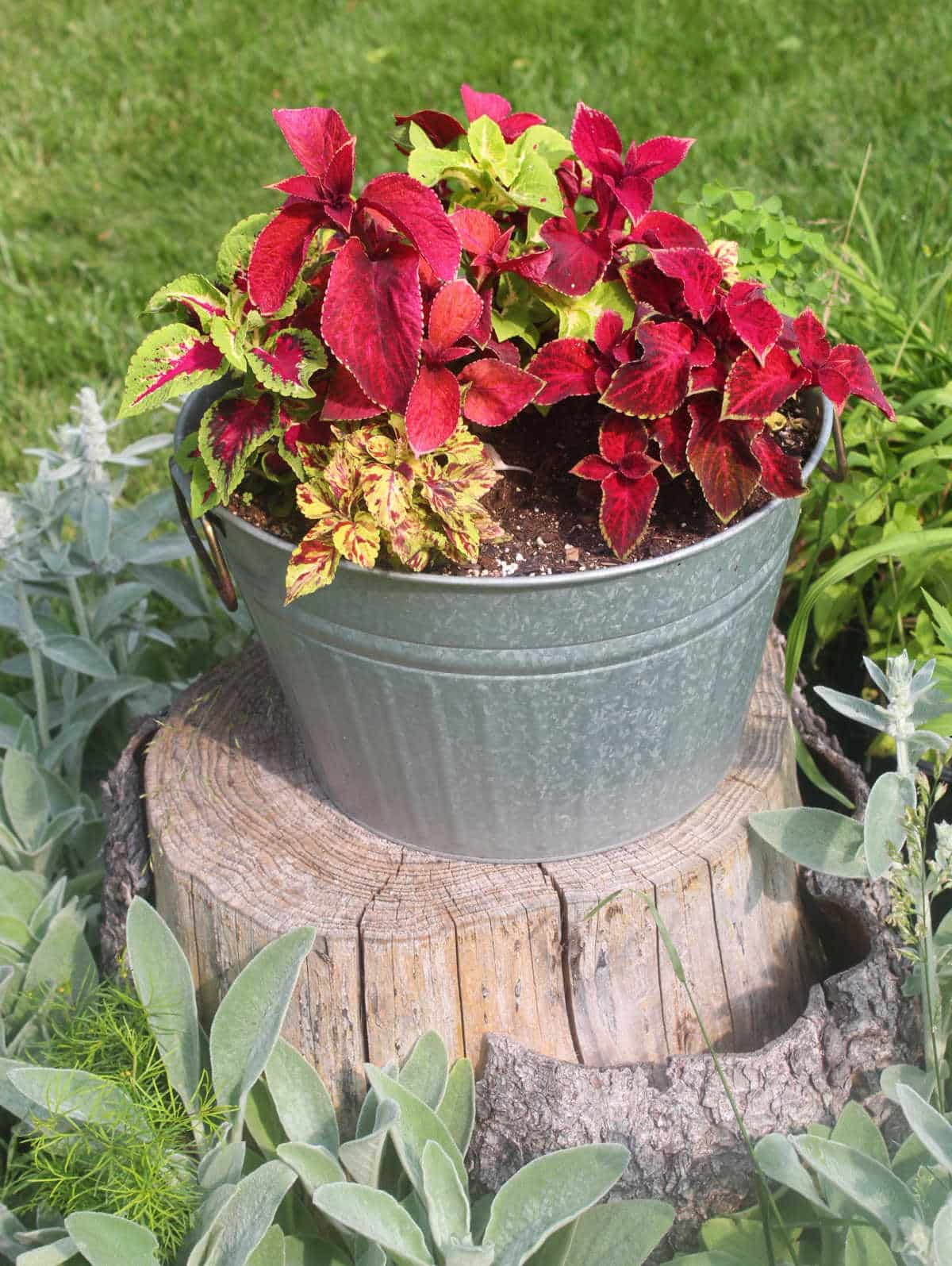
This provides a fun pop of color in that area.
Lily of the Valley
This is a plant that is commonly found in shade gardens of older homes. Like my 100-year-old home. The fragrance of this plant is heavenly. It flowers in the spring. Other names for it are But it is a super aggressive plant and has invasive tendencies. It's another plant that I'm surprised is still sold by gardening centers.
The USDA zones include 2 - 7, which is probably why it can be so aggressive. I live in zone 5, and some of our winters are brutal. A plant that can survive in zone 2 is really tough!
The other big issue with this plant is all parts of it are poisonous. For such a little plant, it can create multiple problems.
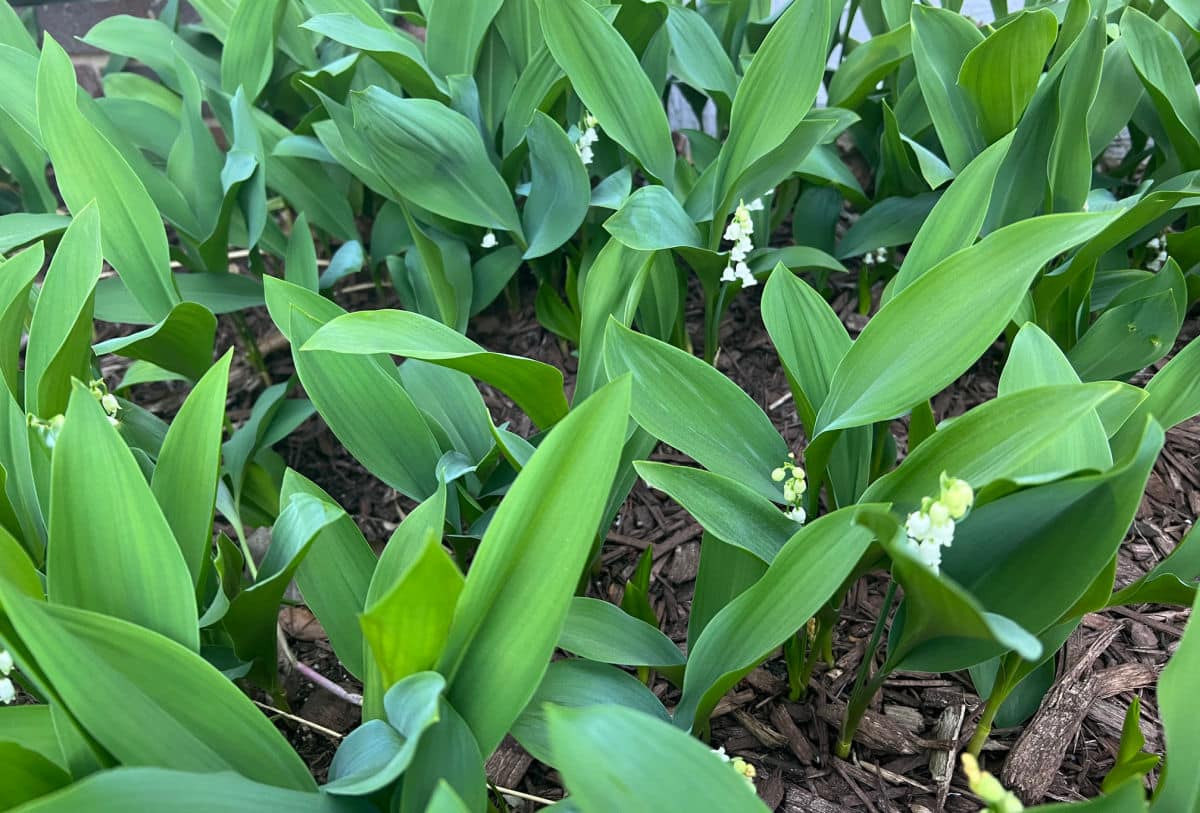
Here is a closeup of the pretty bell-shaped flowers.

Lungwort
The proper name for lungwort is pulmonaria. This specific one is actually called Raspberry Splash. I love the way the leaves are variegated on this plant. It really stands out in the garden! It is USDA zoned from 4 - 9.
Most lungwort plants are shade plants. This Raspberry Splash is a newer variety that is described as full sun. I made an assumption when I bought this one and planted it in a very shady area of my yard.
BUT it's happy there and bloomed profusely.
Gardener TIP
If your plants are flowering profusely and they are not stretching for the sun, then they are planted in a suitable location for them. This is how I know my plants are doing well, even when I plant them in the shade when they should be in the sun.
You really need to observe the sun and shade patterns that actually exist in your yard. Per my example above, in the spring, when the trees hadn't filled out yet, a traditionally shady area was sunny.
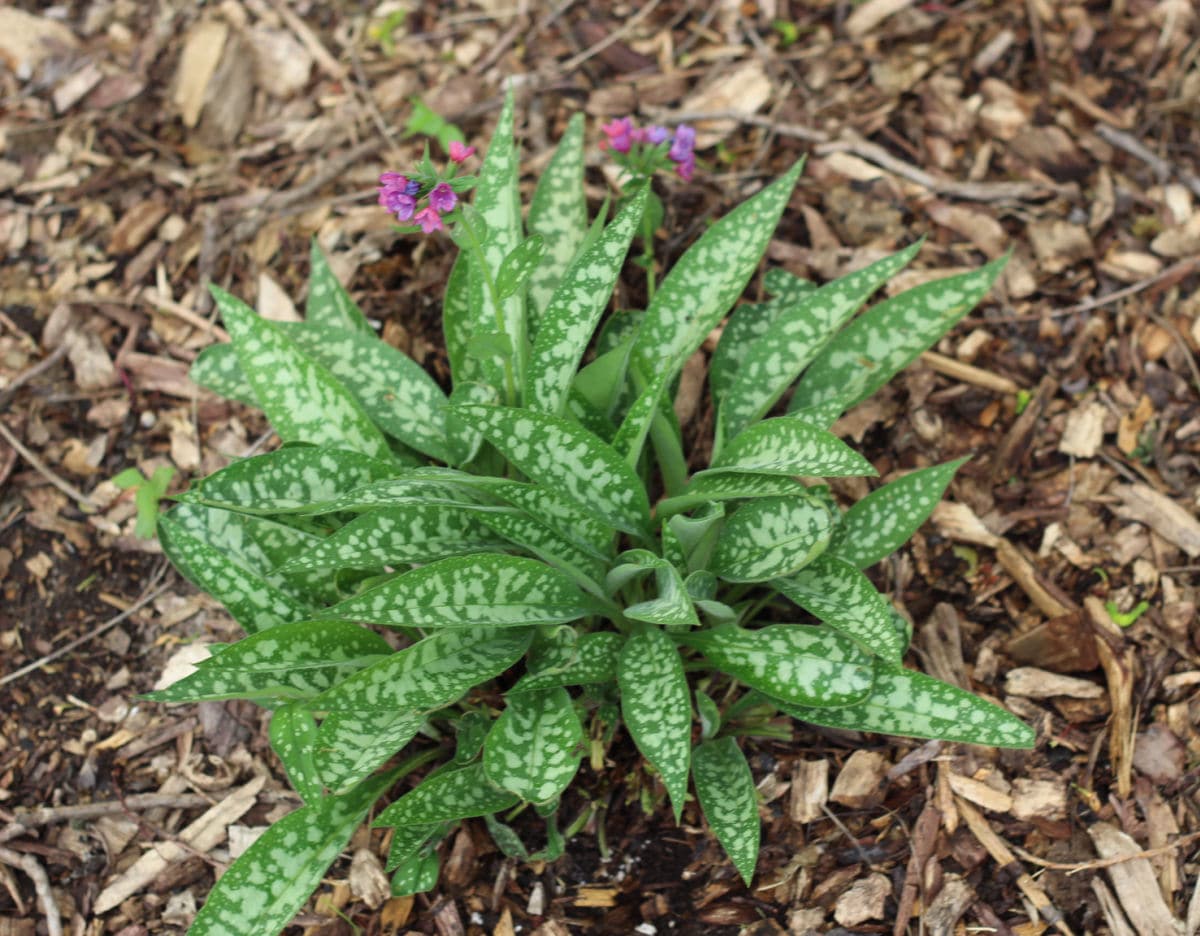
The flower is so pretty! It showed up in the spring and was a welcome sight!
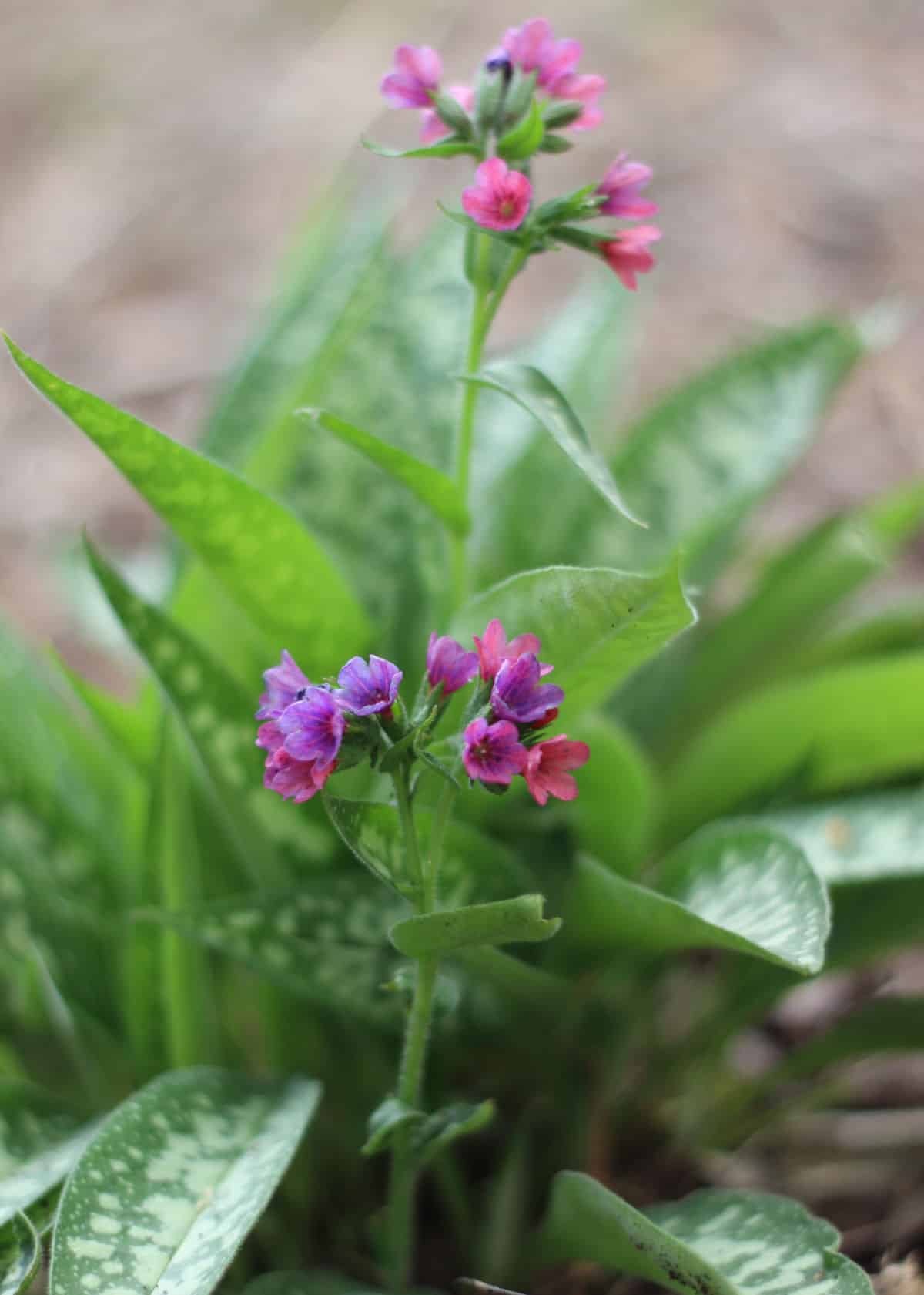
Dianthas
I consider this a bonus groundcover plant. Every time I see it, I am thankful for the pretty flowers and their ability to self-propagate (slowly and in a controlled manner).
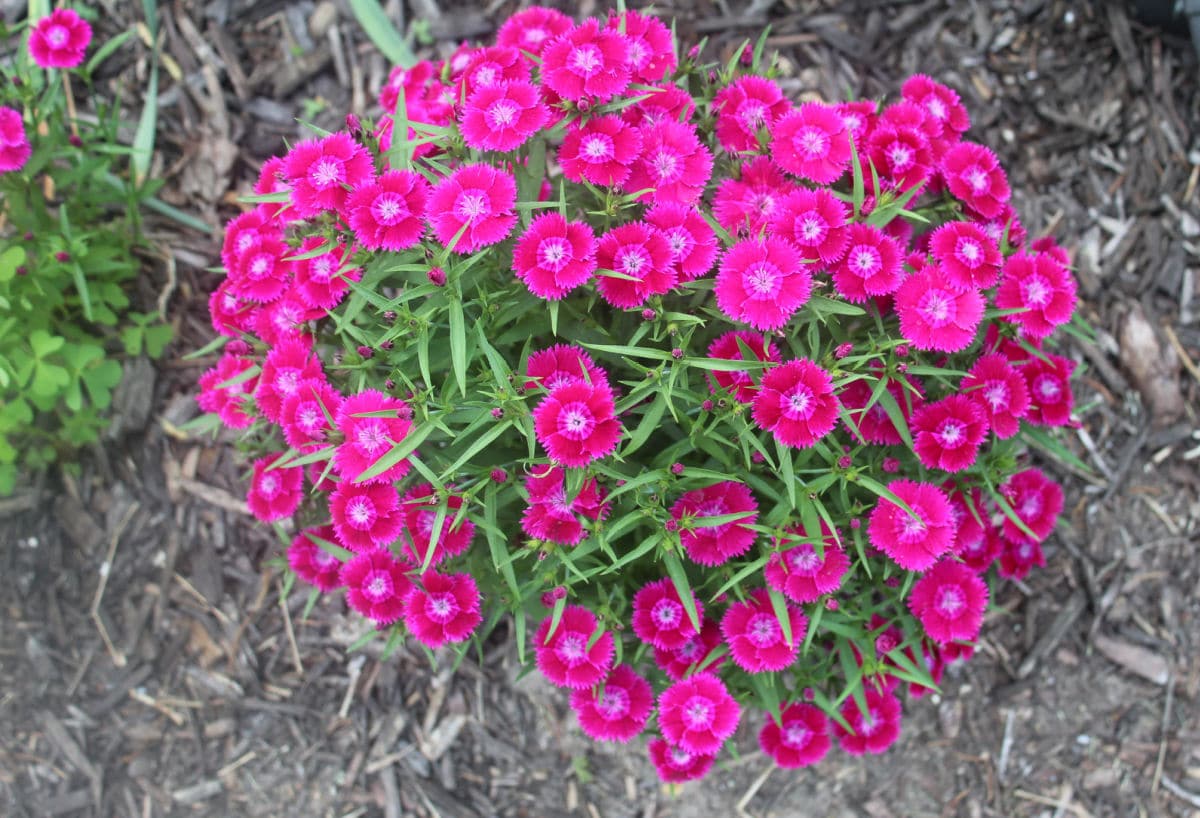
Dianthus are rated and sold as annuals in my area. But they keep coming back. Even after harsh winters. I LOVE this bright color, and I keep splitting this plant and planting it in other areas. A bonus plant because I paid about $2 for a little container holding 6 plants. And I've had them for 4 years now!
Sources for ideas and inspiration
One of the best sources of ground cover plant inspiration has been visiting my neighbors' shade gardens. Sometimes it's where it's planted in relation to other plants or structures in the garden that make them stand out. See what grows well in your area and speak to their owners about the benefits and drawbacks of the specific plants.
Do some of your own research, though! Even I made an error and planted an invasive plant in my yard. It's controllable because I know that plant's growth tendencies now.
More shade plant information
The posts below are all about shade plants that I have personal experience with. Take a look!



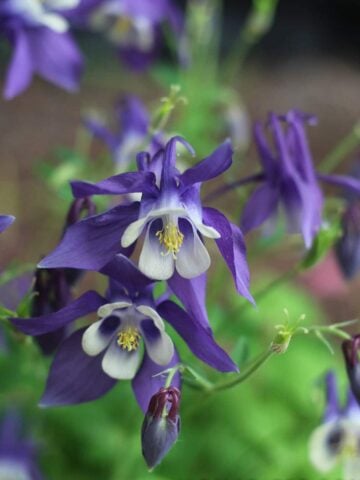

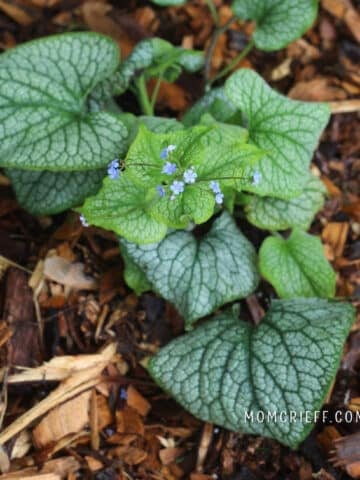
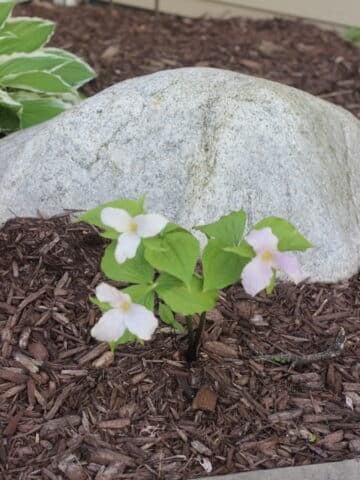
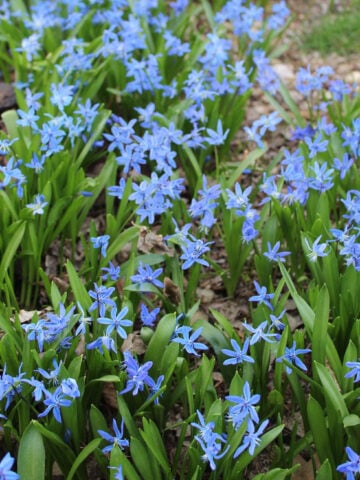
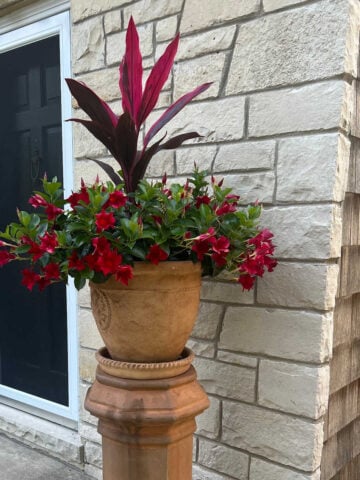
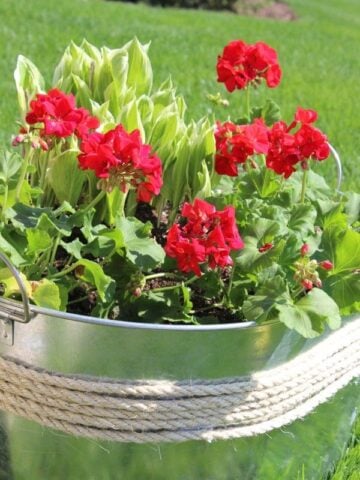
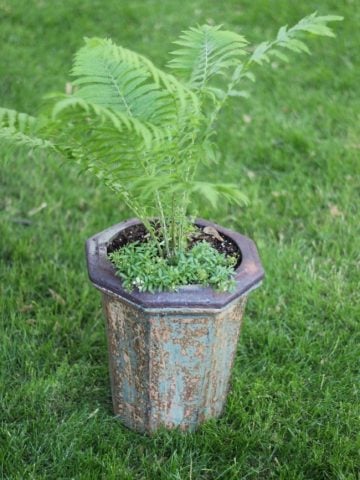
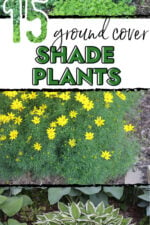
Leave a Reply